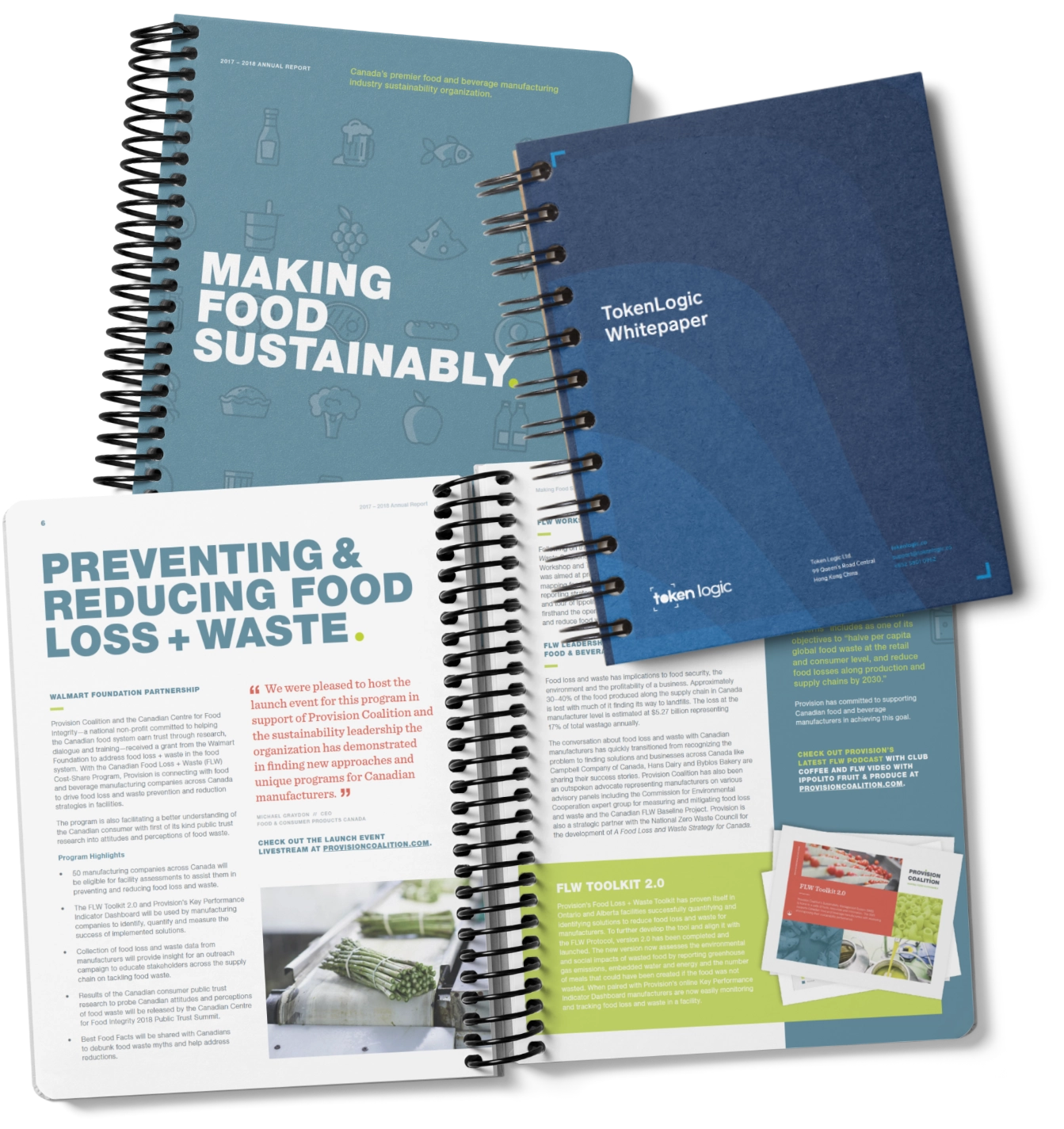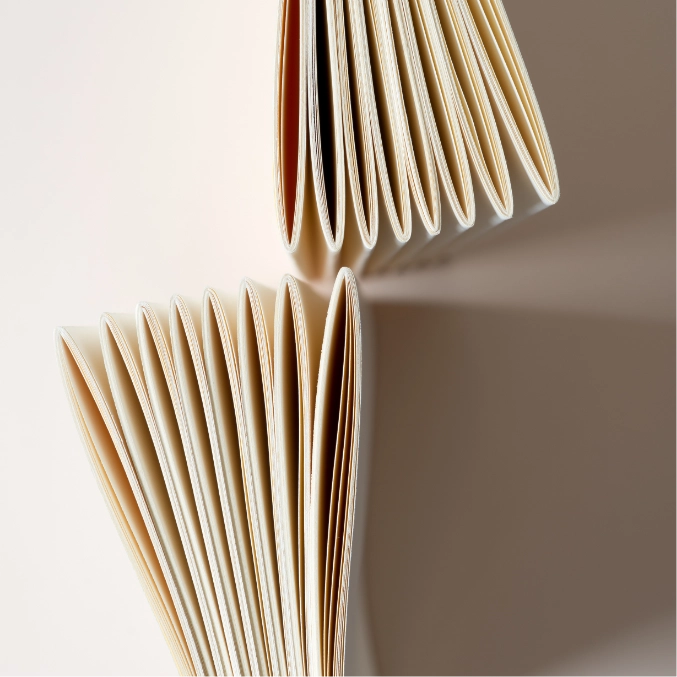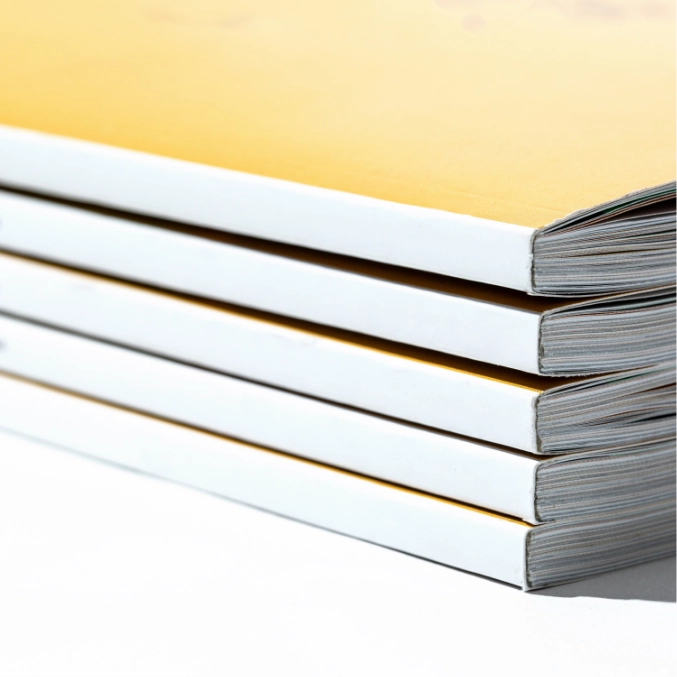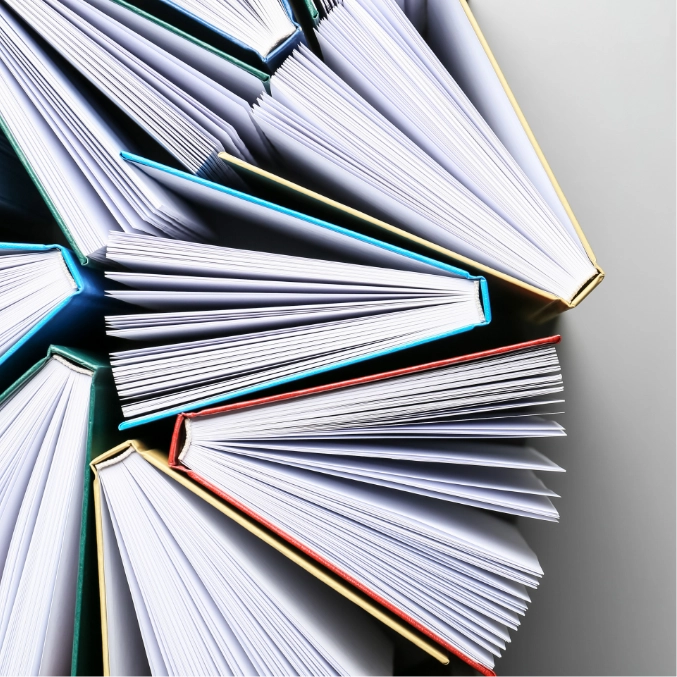Coil Bound Book
Print and bind your publication with flexibility. Choose Coil or Wire-O Bound for your next book.
With Print Your Books you can customize your coil bound books with different coil colours and sizes, paper types, and cover options, all while enjoying the convenience of a quick turnaround time.

about the binding Process
What is a Plasti-Coil or Wiro Bound Book?
A coil bound book, also known as spiral binding or coil binding, is a bookbinding method that uses a continuous plastic or metal coil to hold the pages together. This method is commonly used for notebooks, manuals, reports, calendars, and other types of documents. The coil bound book is typically more than 48 pages with the need to have the pages lie flat when the book is open.
Here’s how the coil binding process works:
- Page preparation: The pages of the book are printed and trimmed to the final size, typically with consistent margins on 3 sides, with the spine requiring 0.5 inch for binding.
- Punching holes: Holes are punched along the edge of the pages, usually on the left side. The number of holes depends on the size and type of coil being used.
- Inserting the coil: The coil, which is a continuous plastic or metal wire, is inserted through the punched holes. It is threaded through the holes by a coil binding machine. The coil usually starts from the front cover and goes through all the pages before ending at the back cover.
- Crimping the ends: Once the coil is inserted, the ends are crimped or bent to prevent the coil from slipping out. This step ensures that the coil remains securely in place.
- Trimming excess coil: The excess coil protruding from the ends is trimmed and cut off to create a neat and finished appearance.
The result of coil binding is a book that can be opened completely and lays flat when open. This makes it convenient for reading, writing, and photocopying. The coil binding method also allows for easy page flipping and adding or removing pages as needed.
Is this option appropriate for my book
Why Choose Coil Bound?
Coil bound books offer several advantages, including:
- Durability: The plastic or metal coil provides durability and allows the book to withstand frequent use and handling. It can handle bending and flexing without breaking or damaging the binding.
- Full-page access: Since the book can lay flat and open 360 degrees, users have full access to each page without having to hold the book open or flatten the pages manually.
- Flexible page count: Coil binding can accommodate a wide range of page counts, from a few pages to hundreds of pages. This makes it suitable for various document types, including those with variable content or frequent updates.
- Customizable: Coil bound books allow for customization options such as choosing different coil colours to match branding or aesthetic preferences.
- Cost-effective: Coil binding is generally a cost-effective binding method, making it suitable for projects with a limited budget.
Things to remember
What you Need to Know.
It’s important to note that a coil bound book does have some limitations. The coil can sometimes snag or get caught on other objects. Additionally, it may not be suitable for books that require a high level of sophistication or a traditional book appearance.
When setting up design files for coil bound printing, follow similar steps as for other print projects, such as determining the trim size, page order, margins, and bleed. Consult with Print Your Books for any specific design guidelines or specifciations for coil bound books.
Set yourself up Right
Set yourself up Right
What file do I supply? Today, most files are supplied as a PDF, alongside the native InDesign files. To set up your design files for coil bound printing, follow these steps:
- Determine the final trim size: Decide on the desired dimensions for your printed book. Common sizes include 8.5 x 11 inches or 5.5 x 8.5 inches. Make sure your design document is set to the correct dimensions.
- Set up margins and bleed: Determine the appropriate margin size for your content, keeping in mind the need for sufficient space between the text or images and the trim edge. Additionally, include a bleed area of typically 0.125 inches (3 mm) beyond the trim edge to account for any elements that extend beyond the page. This ensures that there are no white borders after trimming. Adjust your document’s margins and bleed settings accordingly.
- Choose the hole punching pattern: Coil binding typically requires a specific hole punching pattern to accommodate the chosen coil size. The most common patterns are 4:1 (four holes per inch) or 5:1 (five holes per inch). Choice is based on equipment used at Bindery plant.
- Organize page order: Arrange your pages in the correct reading order, ensuring they flow logically from start to finish. Consider front matter (title page, copyright page, etc.), table of contents, chapters, and any back matter (appendix, index, etc.). Confirm that your pages are properly sequenced and in the correct orientation.
- Account for safe zones: Allow for at least a 0.5 inch a safe zone away from the trim edge. Ensuring important content, such as text or images, is kept within. This prevents the risk of crucial elements getting trimmed off during the production process.
- Design the cover: If your coil bound book requires a separate cover, design it separately from the interior pages. Include the front cover and back cover. Consider incorporating relevant artwork, images, titles, author names, and other essential information.
- Convert fonts to outlines: To avoid font issues during printing, convert your text to outlines or embed the fonts within your design file. This ensures that the text remains intact and is displayed correctly, regardless of the fonts installed on the printing system.
- Proofread and review: Before sending your files for printing, carefully proofread all text, check for any design inconsistencies or errors, and review the overall layout. It’s essential to ensure that your content is accurate, formatted correctly, and ready for printing.
Cost-Effective
Book Printing
With a wide range of economical options, you can print your publication without breaking your budget. Get a professional finished product, at the best price possible.
Large & Small
Scale Projects
Have a large corporate report or annual summary you need printed for your next conference or meeting? Print it with us, we do both small and large quantities.
Hassle Free
Coordination
Our top 6 features
What to consider when printing your coil bound book.
It is important to review your options and prepare your book properly for print. The type of book, orientation, page count, colour and/or black and white, and paper stocks are amoung the things to consider.
Firstly, choose your desired binding option coil bound based on your budget, quantity, and quality requirements. Paper type and weight influence the book’s feel and durability, so select them thoughtfully.
Choose the final colour and cover coating, while ensuring proper formatting and proofreading are in place to eliminate errors. Speak with our trusted professionals that can guide you through the process and options.
Book Orientation
Formatting
Choose your standard 8.5 x 11 book or specify the unique size.
Paper Type
Select a matte or silk finish for your paper type, or request a speciality paper.
Page Count
Outline the numbers of pages (each page in your pdf or each side of a sheet of paper). Blank pages are counted.
Colour
Coating
Consider the options for the cover lamination: coated gloss, coated silk or coated matte.
Coil Bound Price Comparison
Coil bound book printing is a cost effective printing method recommended for brochures, catalogues, magazines and publications. The cost can vary depending on the specifications and quantity needed. For a custom quote, click here to fill out the form and we will be happy to provide you with an estimate.
250 Coil or Wire-O Book
$1,125
# of Pages: 32 + Cover
Size: Standard 8.5 x 11
Cover Stock: Full Colour .012
Paper Stock: 70 lb Glossy or Matte
Colour: Black/White Interior
Shipping: Low Weight
Turnaround: 5 Business Days
$1,560
# of Pages: 32 + Cover
Size: Standard 8.5 x 11
Cover Stock: Full Colour .012
Paper Stock: 70 lb Glossy or Matte
Colour: Full Colour
Shipping: Low Weight
Turnaround: 5 Business Days
1000 Coil or Wire-O Book
$3,750
# of Pages: 32 + Cover
Size: Standard 8.5 x 11
Cover Stock: Full Colour .012
Paper Stock: 70 lb Glossy or Matte
Colour: Black/White Interior
Shipping: Medium Weight
Turnaround: 5 Business Days
$5,100
# of Pages: 32 + Cover
Size: Standard 8.5 x 11
Cover Stock: Full Colour .012
Paper Stock: 70 lb Glossy or Matte
Colour: Full Colour
Shipping: Medium Weight
Turnaround: 5 Business Days
5000 Coil or Wire-O Book
$12,475
# of Pages: 32 + Cover
Size: Standard 8.5 x 11
Cover Stock: Full Colour .012
Paper Stock: 70 lb Glossy or Matte
Colour: Black/White Interior
Shipping: Heavy Weight
Turnaround: 10 Business Days
$13,980
# of Pages: 32 + Cover
Size: Standard 8.5 x 11
Cover Stock: Full Colour .012
Paper Stock: 70 lb Glossy or Matte
Colour: Full Colour
Shipping: Heavy Weight
Turnaround: 10 Business Days
Note: Costs are estimated in Canadian Dollars. All estimates are for budget planning purposes only, final costs will be updated to reflect changed specifications once quoted on. Turnaround time is based on final print proof approvals. Cost examples shown reflect costs for Wire-O, coil binding can be more cost effective. Courier charges and taxes are not included. For clients in the United States, all books are shipped from Canada, no Canadian taxes will apply.
Mirian Moreno, Metals Focus
They listen to my needs and provide solutions meeting all of the deliverables I put before them. Honesty and integrity in all dealings with them has kept me as a loyal customer.
Bert Steenburgh, Executive Coaching
Neil Phillips, DGN Marketing Services Ltd.
Geoffrey Johnson, EnVille
Get the assistance you need
Looking for help with your Custom Coil Bound Book?
Leave it to us to determine the best printing method, book style, paper quality and setup for your unique book. Our experts are happy to help and suggest a variety of options for your next catalogue, annual report, magazine or booklet. Get more out of your book printing today.
- High Quality Offset & Digital Printing
- Colour & Black / White Printing
- Variety of Paper Choices
- 360° File Inspection
- Competitive Pricing
- Fast Turn Around Time
Quote your Coil Bound Book Today
Please note we only fulfill minimum orders of 20 books.
Alternative Types of Book Printing

Saddle Stitch Book
Turn your report into a saddle stitch book.
Saddle stitch is the most popular and cost-effective binding method for small booklets.

Perfect Bound Book
The perfect high-end feel to your corporate catalogue.
